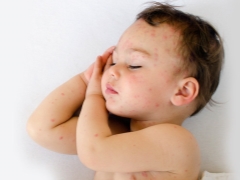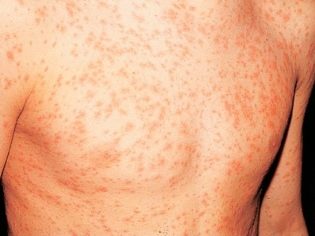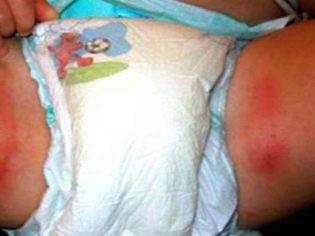Rash on the body and itching in a child
Various rashes on the body in babies are quite common. The development of rashes can lead a variety of diseases, which are discussed in our article.
Causes of
Rashes on the body of a child are an important symptom that indicates trouble in the children's body. A rash can appear in both newborn babies and schoolchildren and adolescents. Localization of rashes is the most diverse. Itchy elements bring the baby strong discomfort and significantly impair his well-being.
Main reasons:
- The leading cause of itchiness and rash on the baby’s skin - allergic pathologies. They can develop at any age. Often the cause of the appearance of adverse symptoms on the skin of infants are various foods, introduced into the diet in the first year of life. Older children tend to react violently to honey and propolis, seafood and sea fish, citrus fruits and chocolate.
- In some cases, the development of contact forms of allergy leads to allergens directly on the skin. This situation is facilitated by the use of improperly chosen baby cosmetics or laundry detergents. Chemical fragrances and colorants contained in such industrial products can have an aggressive effect on the delicate skin of a baby and lead to the appearance of adverse allergy symptoms.
Most allergic pathologies are accompanied by the development of pronounced itching. He can disturb the baby both day and night. This leads to the fact that the child becomes more irritable, more naughty. Babies may be worse attached to the chest. In some cases, the child increases sleepiness and apathy.
- Quarantine children's infections - Also not a rare reason for the appearance in the baby of itchy skin rashes. Measles, rubella, chicken pox, scarlet fever and many other infectious pathologies are provoking causes of the appearance of various skin changes. The rash can spread to the hips, back, heels, head, back of the head, stomach, chest and other anatomical zones. The course of an infectious disease is usually severe and is accompanied by a high rise in body temperature.
- Personal hygiene violation may also contribute to the appearance of a rash on the child’s skin. In this case, they most often appear on the palms and feet, under the arms, behind the ears. Quite often, such rashes appear in very young children who are not yet accustomed to observe the rules of personal hygiene. Itching in such cases may not always be present.
- Itchy, red spots on the baby’s skin may appear and after bites of various insects. This happens mainly in the warm season, when insects are active. Most bites are commonly found in exposed areas of the body. Toddlers living near a forest or in a rural area have a higher risk of such skin elements.
- The appearance of characteristic rash on the skin can also lead to some viral diseases. So, infectious mononucleosis is a fairly common cause of a rash on a child’s skin. Usually the appearance of rashes is accompanied by a pronounced symptom of intoxication. The sick kid feels very bad, his appetite decreases and his sleep is disturbed. Treatment of infectious mononucleosis requires the selection of a complex of individual therapy.
- Scabies is an infectious disease.accompanied by the appearance of a small rash on the skin. Usually it is localized in areas with high humidity or in the area of skin folds. Palms, inguinal area and abdomen are favorite places for scabies mites. This disease is manifested by the presence of many small red spots on the skin that are very itchy and bring pronounced discomfort to the baby.
- In some cases, a skin rash is a symptom of a very life-threatening disease. These pathologies include meningitis. Some forms of this disease cause a child to have multiple scarlet rashes on the skin. This symptom is an extremely unfavorable sign. Treatment of meningitis is carried out only in stationary conditions.
- Skin rash in newborns and infants may develop in some other situations. These include excessive overheating and baby wrapping in the warm season. This contributes to the violation of thermoregulation, which ultimately manifests itself in a child with the onset of symptoms of chickpea. These manifestations occur on the skin of the baby in places of direct contact with clothing.
- In small patients, the development of whitish lesions on the skin can lead to toxic erythema. This pathological condition is characterized by the appearance on the skin of a large number of white skin elements that are close enough to each other. As the disease progresses, such eruptions may already cover the entire body of the baby. Scientists have not established a single reason for the development of this pathological condition in children.
- In adolescence, children may appear on the face, neck, chest and upper back in children. pustular rash. Inside these skin lesions is pus. When pressed, it easily runs out. The appearance of such pustules is associated with changes in hormonal levels, which is manifested in adolescents during puberty. To eliminate the adverse symptoms, a proper selection of medical cosmetics is required, and in some cases also oral medication.
- The development of rashes in a baby can lead to neurodermatitis. This condition is accompanied by a rash in the folds of the arms and legs, as well as in the face area. This disease has mainly neurological causes. Accompanied by the appearance of a rash, as a rule, severe itching. For the treatment of these adverse symptoms used a range of different medicines.
- Various subspecies can also lead to the appearance of loose elements on the skin in babies. herpes viruses. They can cause a roseolous rash. The clinical signs of this infection in many cases duplicate the symptoms of normal fever, which is often found in babies. The pathology is, as a rule, severe and is accompanied by a strong rise in body temperature, the values of which can even reach 40 degrees.
- Fungi settling on the skinmay also cause rash to develop. In this case, the rash appears on almost all parts of the body. Most pathogenic fungi love to live in the scalp, nails, as well as in places of skin folds. Increased sweating only creates more favorable conditions for the reproduction of fungal pathogenic flora. The development of adverse symptoms is usually gradual.
- Fungal pathologies are most common in babies with signs of immunodeficiency. Also at risk for the development of fungal rash are children suffering from diabetes and other metabolic diseases.To eliminate the unfavorable symptoms of a fungal infection, a treatment complex is needed that includes the use of antifungal drugs.
Symptoms
Appearance rash can be very different. Quite often, numerous spots appear on the child’s skin. They may be red or pink in color. Usually in their size, they reach 5-8 mm.
Allergic specks usually itch much and spread almost throughout the body. A large accumulation of skin elements is located on the back, neck, feet, elbows and other parts of the body. Allergic rash is usually quite small and itchy. The appearance of these lesions is directly related to the ingestion of a child of some allergen.
Many infectious diseases are manifested by the appearance on the skin of a baby. wheal. Chickenpox usually proceeds this way. In this disease, the child appears numerous blisters that cover almost all of the skin. Usually there is a yellow or bloody fluid inside them. Bulk elements can persist for 5-7 days, and then gradually disappear completely.
A baby’s skin rash can also manifest itself with various vesicles. These are relatively large bubbles filled with serous fluid inside. The wall of such formations is usually dense, but can crack when touching them. In this case, the fluid expires outside, and a bleeding wound remains in place of such an element. These manifestations are often found when the skin is infected with certain pathogenic staphylococci.
The appearance on the skin of infants bright red areas that can itch very much, is a sign development of diaper dermatitis. Quite often, wearing incorrectly chosen diapers leads to this situation. The development of an allergic reaction can be promoted by the chemical components of the absorbent layer, which is in direct contact with the child’s inguinal area. The appearance of bright spots in the groin, buttocks and thighs at the breast can be a characteristic symptom of diaper dermatitis.
Occurrence of skin rash rarely becomes an isolated symptom. The general condition of the sick baby also worsens. His appetite decreases and his mood changes. The child becomes more capricious, refuses to play with your favorite toys.
Severe itching leads to the fact that the baby increases nervousness. Many infectious diseases occur in a child with development severe intoxication syndrome. A sick baby rises in body temperature. At its height may appear fever or chills.
A child starts to have a bad headache, dizziness and general weakness may develop. The skin becomes dry and pale, to the touch they are usually cold.
Diagnostics
Only the attending physician can determine the specific pathology. To do this, you should definitely show the child to the doctor when any rash appears on his skin. Pediatricians are engaged in the treatment of infectious diseases in babies. If the pathology has a fungal or bacterial origin, then pediatric dermatologists also join the treatment.
To establish the correct diagnosis A mandatory series of tests is required. Complete blood count can detect any signs of bacterial and viral infections. Increased ESR indicates the presence of inflammation in the children's body. A large number of neutrophils suggests that the cause of the rash on the skin could be some kind of allergic reaction or bacterial infection.
To determine the causative agent of the disease and differential diagnosis in some cases carried out collection of biological material from the skin. This is required for scraping.The resulting material is sent to the laboratory, where laboratory doctors conduct a thorough study of it and determine the causative agents of skin disease.
In some difficult cases of diagnosis, more accurate tests are also required - PCR or ELISA. These studies are necessary to establish a number of microbes that cannot be detected by any other methods or laboratory tests. The biological material for such examinations is venous blood.
Using the detection of specific antibodies, a variety of childhood infections are diagnosed.
How to treat?
The most important condition for the correct treatment - the establishment of the correct diagnosis. Selection of the treatment regimen is carried out individually, taking into account the reason that caused the occurrence of adverse symptoms in the child. Various antihistamines are used for the treatment of allergic rashes. They can be used as ointments, creams or tablets. These tools include «Claritin"," Suprastin "," Zyrtec " other.
The duration of taking antihistamines is usually 7-10 days. They are appointed, as a rule, 1-2 times a day. After taking the first doses of medicines, the baby begins to feel much better. It reduces itching, improves mood and sleep. For course use can also be used by other groups of drugs that are well combined with antihistamines.
You can also use it to treat itchy rashes. lotion with medicinal herbs. To do this, chamomile, calendula, series. Brew such herbs should be in accordance with the instructions for packaging.
Apply them to the complete elimination of skin rashes. Also, these herbs are suitable for the prevention of education on the skin of various rashes.
If a staphylococcal or streptococcal infection has led to the appearance of the baby’s skin, then antibiotic prescription. Penicillins, macrolides and cephalosporins of the latest generations are the most successful in coping with such pathogenic flora. These funds can be used both in the form of tablets and through injections. The course of treatment is usually calculated for 5-10 days, depending on the initial type of microorganisms that caused the development of this disease.
To eliminate other associated symptoms used symptomatic therapy. Thus, it is possible to normalize high body temperature through the use of antipyretics. In children, drugs based on paracetamol and ibuprofen. These tools have a minimum of side effects and can quickly improve the health of the child.
Multivitamin complexes are also used for quick recovery. These medicines contain in their composition the quantity of vitamins and microelements necessary for the children's organism. These components help to restore the immunity of the baby weakened during the illness and improve its general condition.
Multivitamin complexes can be used for 1-2 months.
About what may be a rash in children, see the following video.










































